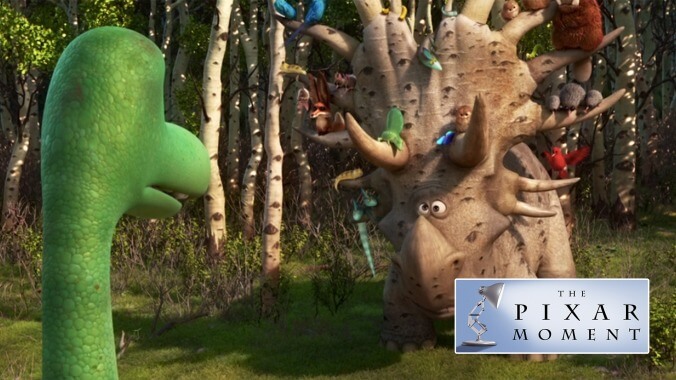Pixar finally laid an egg with The Good Dinosaur, but its failures are interesting
Image: Image: Screenshot
For years, Pixar was renowned for its rigorous development process, which sometimes involved the radical re-envisioning of projects at seeming impasses, with stronger, battle-tested movies the end result. The Good Dinosaur wasn’t the first time that the process failed to produce a unmitigated triumph (Cars 2 zoomed through, after all), but it may be the Pixar project whose growing pains are most visible. Though pushed back several times, it still wound up playing like a movie that made its eventual November 2015 release date whether it was ready or not.
The 20 years of (mostly) expertly executed family entertainment that preceded The Good Dinosaur offer context for its disappointments, creatively and financially; the film has scant big laughs, set pieces, or subtext. At the same time, there’s something oddly charming about the movie’s refusal to be hammered into shape. Initially described as a story asking what would happen if dinosaurs never went extinct and continued to live as humankind developed, the movie doesn’t offer a dino-centric world on par with the bustling, pun-heavy environments Pixar created for fish, monsters, bugs, or cars. Instead, it begins on a placid dinosaur family farm, following the fearful struggles of Arlo, a young Apatosaurus. To the extent that the story kicks into gear, it does after Arlo loses his father, gets separated from the rest of his family, and is forced to face his fears as he searches for a way home.
Arlo’s journey is essentially a patchwork of vignettes. Early in his adventures, he encounters a Styracosaurus with a menagerie of smaller, brightly colored creatures sitting on his many horns. His eyes are glazed and twitchy, he speaks in a distant monotone (“we thought you were going to die, then you didn’t”), and seems to be taking instructions from a chirping red bird perched next to his ear. This mysterious collective demands custody of the feral human child who Arlo is beginning to befriend, and engages in a naming contest, which Arlo “wins” when the kid more or less responds to “Spot.”
The Styracosaurus, who speaks obtusely and imparts no real wisdom, is never seen again. His appearance is brief, with questionable plot utility; it’s also memorably eerie, and a representation of the movie’s overall visual style in miniature. The dinosaur is cartoony looking, with googly eyes, while the animals mix exaggerated cuteness with more photorealistic renderings, just as the rounded, bright green, big-eyed Arlo interacts with eye-popping and often quite believable vistas. It’s genuinely difficult to parse whether this contrast was always the vision for the project, or whether it’s a hybrid of different sensibilities. Like so many Pixar projects, The Good Dinosaur switched directors midstream, with frequent Pixar writer/co-director Bob Peterson handing off to fellow studio vet Peter Sohn (who also voiced the Styracosaurus).
Though he’s played by the project’s replacement director, the Styracosaurus feels like he could be a remnant from another iteration of the project. He’s the most visually distinctive among a series of dinosaurs—cackling pterodactyls, a couple of cowpoke Tyrannosaurus—that, much like the assortment of creatures on his head, never cohere into a functioning ensemble. This is unusual for Pixar but hardly unprecedented for its parent company. Specifically, the ambling, vignette-heavy pacing of The Good Dinosaur recalls Disney cartoons of the 1960s, both in its wandering eccentricity and its lack of thematic ambition. (It’s no accident that the point-of-view character is a child, rather than a conflicted parent figure.)
The mix-and-not-quite-matched approach makes The Good Dinosaur an inessential Pixar movie—and is that really such a bad thing? By this point in its filmography, the studio had plenty of established tropes, formulas, and franchises. Divorced from the expectations that Pixar plus dinosaurs would equal a wildly entertaining, critically acclaimed smash, The Good Dinosaur has plenty to offer: some of the studio’s most gorgeous and unusual imagery; a lovely, plaintive scene where Arlo and Spot wordlessly grieve over lost family members; and inspired side doodles like that Styracosaurus. If precision-tuned, rigorously disciplined development can still produce so many diminishing-return sequels, maybe there’s room for the occasional breakdown.